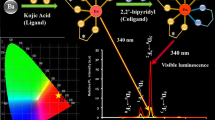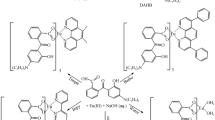Abstract
A novel organic ligand, 6-aniline carbonyl 2-pyridine carboxylic acid (HAP), and the corresponding europium complex, tris(6-aniline carbonyl 2-pyridine carboxylato) europium (III) (Eu-AP) have been designed and synthesized. The results showed that Eu-AP was a conjugated complex, emitting strong red luminescence. The lifetimes of 5D0 of Eu3+ in the complex were examined using time-resolved spectroscopic analysis, and the lifetime value was 0.55 ± 0.01 ms for solid Eu(AP)3. Thermogravimetric analysis showed that the europium complex had good thermal stability.
Similar content being viewed by others
References
S. I. Weissman (1942). Intramolecular energy transfer, the fluorescence of complexes of europium. J. Chem. Phys. 10, 214.
I. Hemmilä (1995). Luminescent lanthanide chelates—A way to more sensitive diagnostic methods. J. Alloys Compd. 225, 480.
J. Moynagh and H. Schimmel (1999). Test for BSE evaluated. Nature 400, 105.
L. H. Slooff, A. Polman, S. I. Klink, G. A. Hebbink, L. Grave, F. C. J. M. van Veggel, D. N. Reinhoudt, and J. W. Hofstraat (2000). Optical proportions of lissamine functionalized Nd3+ complexes in polymer waveguides and solution. Opt. Mater. 14, 101.
D. An, Z. Yue, and R. T. Chen (1998). Dual-functional polymeric waveguide with optical amplification and electro-optic modulation. Appl. Phys. Lett. 72, 2806.
P. K. H. Ho, D. S. Thomas, R. H. Friend, and N. Tessler (1999). All-polymer optical devices. Science 285, 233.
R. H. Friend, R. W. Gymer, A. B. Homes, J. H. Buroughes, R. N. Marks, C. Taliani, D. D. C. Bradley, D. A. Dos Santos, J. L. Brédas, M. LöDylund, and W. R. Salaneck (1999). Electroluminescence in conjugated polymers. Nature 397, 121.
M. D. McGehee, T. Bergstedt, C. Zhang, A. P. Saab, M. B. O’Regan, G. C. Bazan, V. I. Srdanov, and A. J. Heeger (1999). Narrow bandwidth luminescence from blends with energy transfer from semiconducting conjugated polymers to europium complexes. Adv. Mater. 1, 1349.
J. Kido and Y. Okamoto (2002). Organo lanthanide metal complexes for electroluminescent materials. Chem. Rev. 102, 2357.
Y. Cao, I. D. Parker, G. Yu, C. Zhang, and A. J. Heeger (1999). Improved quantum efficiency for electroluminescence in semiconducting polymers. Nature 397, 414.
T. Sano, Y. Nishio, Y. Hamada, H. Takahashi, T. Usuki, and K. Shibata (2000). Design of conjugated molecular materials for optoelectronics. J. Mater. Chem. 10, 157.
B. L. An, M. L. Gong, K. W. Cheah, J. M. Zhang, and K. F. Li (2004). Synthesis and bright luminescence of lanthanide (Eu(III), Tb(III))complexes sensitized with a novel organic ligand. Chem. Phys. Lett. 385, 345.
B. L. An, J. X. Shi, W. K. Wong, K. W. Cheah, R. H. Li, Y. S. Yang, and M. L. Gong (2002). Synthesis and luminescence of a novel conjugated europium complex with 6-parachloroaniline carbonyl 2-pyridine carboxylic acid. J. Luminesc. 99, 155.
B. L. An, M. L. Gong, J. M. Zhang, and S. L. Zheng (2003). Synthesis, bright luminescence and crystal structure of a novel neutral europium complex. Polyhedron 22, 2719.
Y. S. Yang, M. L. Gong, Y. Y. Li, H. Y. Lei, and S. L. Wu (1994). Effects of the structure of ligands and their Ln3+ complexes on the luminescence of the central Ln3+ ions. J. Alloys Compd. 207/ 208, 112.
Y. Hasegawa, M. Yamamuro, Y. Wada, N. kanehisa, Y. Kai, and S. Yanagida (2003). Luminescent polymer containing the Eu(III) complex having fast radiation rate and high emission quantum efficiency. J. Phys. Chem. 107, 1697.
J. J. Lessmann, W. De, and W. Horrocks, Jr. (2000). Supramolecular coordination chemistry in aqueous solution: lanthanide ion-induced triple helix formation. Inorg. Chem. 39, 3114.
L. R. Melby, N. J. Rose, E. Abramson, and J. C. Caris (1964). Synthesis and fluorescence of some trivalent lanthanide complexes. J. Am. Chem. Soc. 86, 5117.
G. Z. Chen, X. Z. Huang, Z. Z. Zheng, J. G. Xu, and Z. B. Wang (1990). Fluorescence Analysis Methods, Science Press, Peking.
Author information
Authors and Affiliations
Corresponding author
Rights and permissions
About this article
Cite this article
An, BL., Gong, ML., Li, MX. et al. Synthesis and Luminescence of a Novel Conjugated Europium Complex with 6-Aniline Carbonyl 2-Pyridine Carboxylic Acid. J Fluoresc 15, 613–617 (2005). https://doi.org/10.1007/s10895-005-2834-6
Received:
Accepted:
Issue Date:
DOI: https://doi.org/10.1007/s10895-005-2834-6




